Introduction
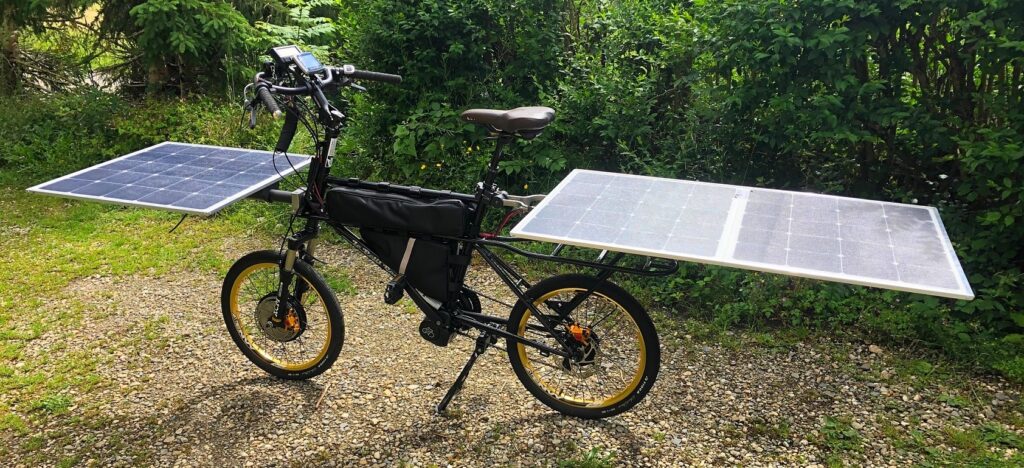
By closely following the different editions of the SunTrip, I noticed that there was no ideal configuration of an electro-solar bike. If this were the case, little by little, all the participants would have arrived at the same conclusions and would have had almost identical machines.
Each solution is the result of the thinking of its designer. Each solution is always a compromise between different criteria such as: weight, budget, reliability, resilience in the event of a problem, repairability, comfort, etc… The bike presented here therefore comes from my choices but which, I hope, can satisfy the greatest number of users.
My selection criteria (subjective)
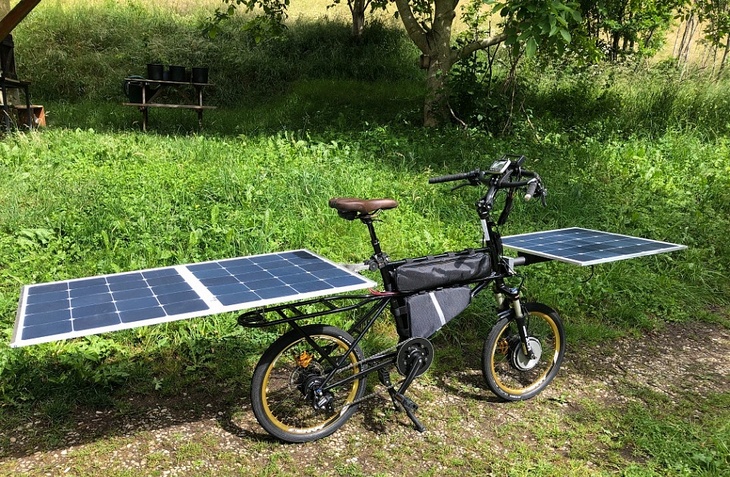
- Handy and not too bulky
- Comfortable
- Solid
- Not too heavy
- Good performance whatever the terrain
- Reliability of solutions
- If possible redundancy of solutions so as not to be left stranded.
Technical description
Cycle part
I chose an upright bike for maneuverability and small footprint, I opted for a mini cargo bike for strength.
“Le Petit Porteur” frame with integrated luggage rack (French manufacturer) . It is a long-tail type steel frame (significant distance between the seat tube and the rear axle) for comfort despite the absence of rear suspension.
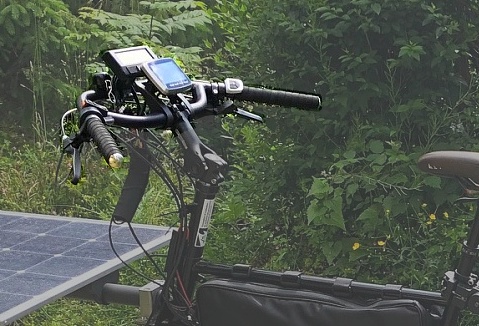
- Good quality suspended front fork (hydraulic and gas).
- 20-inch wheels with reinforced cargo-type rims
- Adjustable and suspended seat tube for comfort.
- Wide and high handlebars for comfort and multiple possible hand positions.
- Adjustable stem.
- Shimano Alfine 11-speed integrated rear hub.
- Hybrid brakes: hydraulic calipers controlled by cables from the handlebars (master cylinder on the caliper).
Motorization
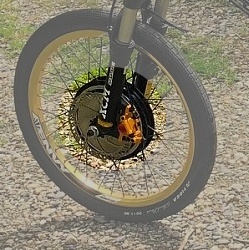
I chose a Direct Drive motor on the front wheel for mechanical simplicity (reliability), the possibility of energy regeneration when descending. The small diameter front wheel (20 inches) avoids the major disadvantage of Direct Drive motors, namely low efficiency at low rotation speed. I had a little difficulty finding a Direct Drive motor that wasn’t too heavy (around 3kg). But I found the Goldenmotor Smartpie model modified and improved by me.
I chose to also install a Bafang crank motor for 2 reasons:
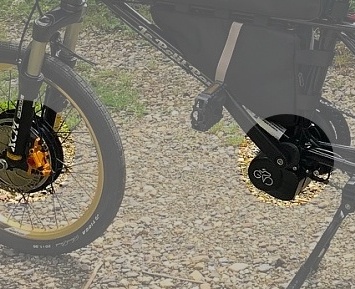
- motorization redundancy, in the event of a breakdown of one of the 2 systems,
- the complementarity of these 2 technologies:
- the pedal motor has better efficiency on hills, at low speed,
- The Direct Drive motor can help with braking on descents and regenerate energy to charge the battery.
Motor control
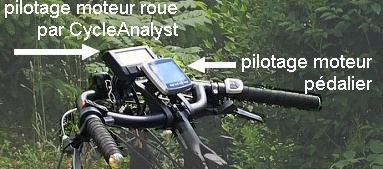
The two engines are “almost” independent from a driving point of view. This allows total freedom of choice of combination of the two motors.
Why “almost”?
Because the front wheel motor is controlled by a CycleAnalyst which measures the overall consumption of the two motors via an external shunt. Its power limitation therefore depends on the power consumed by the pedal motor. The result is that the pedal motor has priority over the wheel motor. If we increase the power of the crank motor, the remaining power for the wheel motor therefore decreases within the limit set at the CycleAnalyst level.
This operation is very pleasant and efficient to use.
The battery
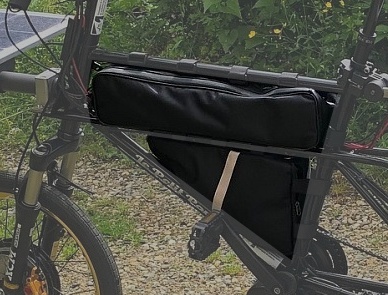
The energy tank is made up of 2 600Wh batteries at 48 Volts nominal. The two batteries are placed in parallel, the overall capacity is 1200Wh. It is easier to integrate 2 batteries rather than one, into the two frame bags. In addition, this redundancy makes it possible to compensate for a failure of one of the two batteries.
Solar equipment
Solar charging is provided by 3 solar panels, for a total of 240Wp:
- 1 90Wp panel at the front,
- 2 75Wp panels at the rear
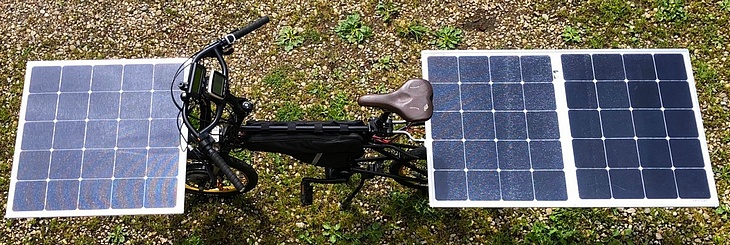
I chose to install 2 panels at the rear instead of just one and each panel is equipped with an MPPT regulator: this makes it possible to overcome the fairly common shading of the area just behind the cyclist, if one panel is in shade, the other can continue to operate. This also offers redundancy, in the event of a charger failure, by bringing together the two panels on the same MPPT regulator, in degraded mode.
The panels can be manually rotated on the longitudinal axis to optimize solar charging.
Feedback
In normal conditions, I observed consumption around 8Wh/km. The battery capacity of 1200 Wh therefore allows a range of approximately 150 km without recharging.
In good summer weather, solar panels produce between 900 and 1200 Wh in a day (between 4 and 5 times the peak power). This allows you to find a full or almost full battery after 120 to 150 km of daily travel.
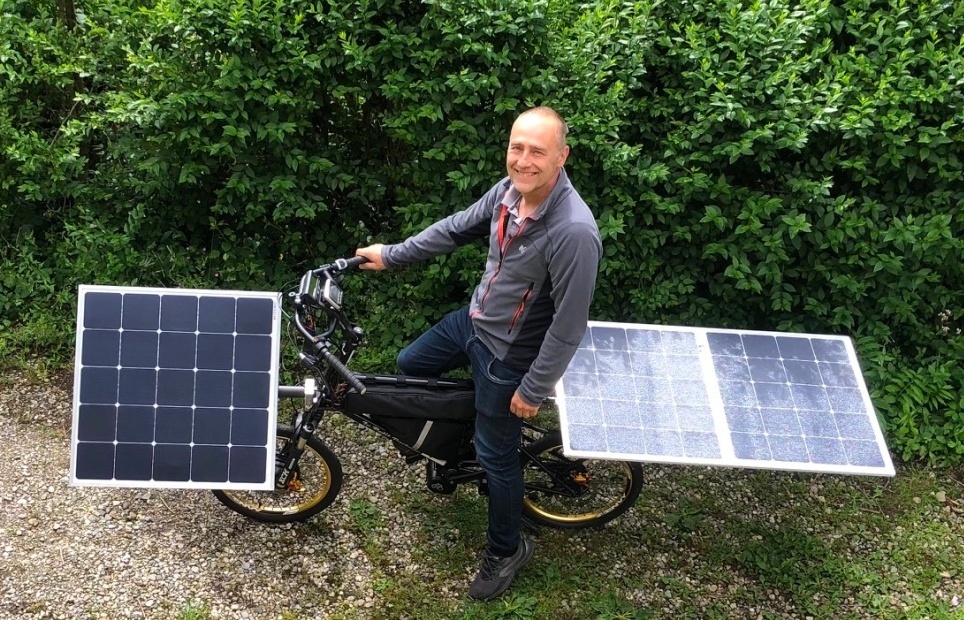
Developments in motorization and batteries
At the beginning, my batteries were 36 Volts. But under 36 Volts, my motor on a 20-inch wheel had a maximum speed of 28 km/h which was insufficient for my taste. So I changed to 48 Volt batteries, which allowed me to reach a speed of 35 km/h with the wheel motor only.
The Tongsheng TSDZ2 36 Volt crank motor had to be replaced by a 48 Volt crank motor, a Bafang brand model.
After 600 km of riding in Corsica with significant elevation changes, I noticed that I had used the pedal motor very little. The small Smartpie wheel motor had not heated up and was sufficient as long as the slopes did not exceed 10%.
On this bike, you can do without the crank motor under 3 conditions:
- do not load too much luggage so as not to increase the weight too much (but we save 4kg by removing the pedal motor),
- abandon the redundancy of the motorization,
- do not climb slopes greater than 10%.
